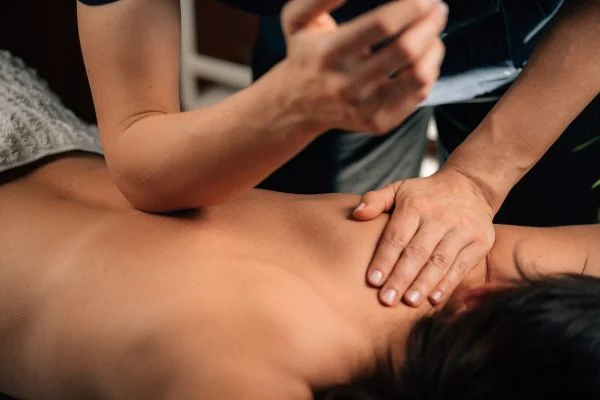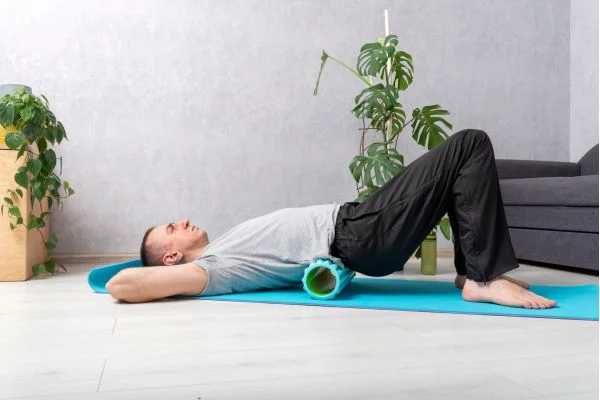If you were asking how to give a massage for hip pain? To give a massage for hip pain, start with a warm-up on the back and thighs. Use techniques like deep tissue, myofascial release, and trigger point therapy around the hip area.
Communicate and adjust pressure as needed. Finish with gentle stretches. Always prioritize the person’s comfort and consult a pro for advanced techniques.
Why Should You Consider Massages To Treat The Pain?
Thinking about going for a massage to deal with pain? Well, it’s a pretty smart move! Massages are like your body’s natural pain relief experiences. They dig deep into the real causes of the pain, like those tense muscles and annoying knots.
Techniques like deep tissue, myofascial, and trigger therapy aren’t about a quick fix. They boost blood flow, chill out tight muscles, and make you all flexible again. The coolest part? No side effects like you might get with meds.
Massages are all about the long game, tackling the root problems. Plus, they’re like a ticket to relaxation, which is important for healing.
Read more about How To Give a Massage for Hip Pain?
Techniques Used For Hip Pain Massages
Dealing with hip pain can throw a wrench in your day-to-day life. Luckily, massages can work wonders in easing that discomfort by focusing on the muscles and tissues causing the issue. Let’s dive into three super effective massage techniques for hip pain. Deep Tissue Massage, Myofascial Release, and Trigger Point Therapy.
Technique 1. Deep Tissue Massage
So, picture this: deep tissue massage is like a superhero for your muscles. It zooms in on those deep layers of muscle and tissue, causing all the trouble.

How It Helps:
- Spot-On Pressure: During this massage apply pressure and slow strokes to tense spots. This works like a charm in breaking down knots and adhesions contributing to hip pain.
- Blood Flow Boost: The pressure applied during deep tissue massage helps blood flow. When your muscles get more oxygen and nutrients, they heal faster and hurt less.
- Flexibility Upgrade: Flexibility is key to beating hip pain. It often involves stretching and lengthening the muscles around your hip joint. More flexibility means less hip discomfort.
Technique 2. Myofascial Release
Think of your fascia as a cozy blanket that wraps around your muscles, bones, and organs. When that blanket gets all bunched up, it can cause hip pain. Myofascial release is about straightening that blanket out and removing those kinks.
How It Works:
- Gentle Pressure: The therapist applies steady pressure to certain points along your fascia. This pressure lets go of tension, giving your muscles more room to move and reducing hip pain.
- Stretching Magic: Stretching is a big part of myofascial release. Your therapist might stretch the tight areas or involve you in some stretches.
- Goodbye Pain: Releasing that fascia tension doesn’t just ease your hip pain. It tackles the root of the issue for long-term relief.
Technique 3. Trigger Point Therapy
Ever had a muscle knot that just wouldn’t quit? That’s where trigger point therapy comes in. It zeroes in on these knots to make them loosen up and let go of that radiating hip pain.
How It Happens:
- Knot Spotting: The therapist becomes a knot detective. Use their hands to find those tense knots causing you all the grief. These knots are usually sensitive and can send pain to your hips and beyond.
- Pressure Play: They apply direct pressure once they locate a trigger point (fancy name for a knot). It could be a steady push or a dynamic move, depending on what works best for you.
- Bye-Bye Referred Pain: The knot starts to give in as the pressure does its thing. This can bring a welcome relief from the pain radiating to your hip. Trigger point therapy helps with the pain and improves your muscle’s work.
Besides these top-notch techniques, therapists often throw in some extra tricks to boost your results:
- Stretching Homework: Your therapist might suggest specific stretches you can do at home. These keep your muscles flexible and prevent them from getting all tight again.
- Hot or Cold Comfort: After your massage, use heat or cold packs on your hip area. It can help with inflammation and give you even more relief.
- Spa Time: Some therapists go for hydrotherapy. Use contrast baths or whirlpools to treat your hip muscles.
- Smart Tips: Therapists love sharing tips about posture, body mechanics, and self-care to stop that hip pain from returning.
Read more about How To Massage Hip Flexor Pain?
How To Give A Hip Massage
You should know the answer to “how to give a massage for hip pain?” Want to learn how to give an awesome hip massage? Whether you’re lending a hand to a friend or a massage enthusiast, here’s a step-by-step guide to nailing a relaxing and effective hip rubdown.
Step 1. Get the Space Ready:
First things first, set the scene. Make the room cozy with dim lighting and a comfy vibe. Maybe some chill tunes are playing in the background. Pile up some pillows or cushions to keep things comfy for the person you’re massaging.
Step 2. Have a Chat:
Check-in with the person you’re massaging. Ask them if they have any sore spots or sensitive areas. This way, you can tailor the massage to their needs.
Grab some massage oil, like coconut, almond, or jojoba oil. Warm it up before using it – it feels nicer on the skin.
Step 3. Start with a Warm-Up:
Get things rolling with a gentle warm-up. Use wide strokes to massage their back, shoulders, and thighs. It helps them relax and gets their muscles ready for the good stuff.

Time for some fancy moves! Use your hands to glide over their skin with moderate pressure. Start from their lower back and work down to their hips. This warms things up and eases tension.
Step 4. Knead the Muscles (Petrissage):
Knead, knead, knead! It’s like bread-making but on their muscles. Use your fingers, thumbs, and palms to gently squeeze and knead around your hips. You can do circles or give little lifts – this helps loosen knots and gets the blood flowing.
Stretching time! Gently stretch their skin and the tissue underneath around their hips. Use your hands to create a light-pulling motion. This technique releases tension and makes them more flexible.
Step 5. Go Deep (Deep Tissue Techniques):
For the brave, try some deep tissue moves. Use your knuckles or elbows to apply some pressure to specific tense spots. Like the glutes and hip flexors. Just check with them to make sure it’s not too much.
Are hip flexors causing a stir? Press gently with your fingers on the front of their hip area where those muscles hang out. Use circles and kneading to help them relax.
Step 6. Find the Triggers (Trigger Point Therapy):
Got trigger points? Give ’em some attention. Press firmly on these points using your fingers, thumbs, or even elbows. Hold for a bit until they feel the relief.
Throw in some gentle stretches. Move their hip joints around to improve flexibility and ease tension. Keep it comfortable and pain-free, though!
Step 7. Wind Down with Gliding Strokes:
Wind things down with more gliding strokes, as you did at the start. It’s a smooth way to bring them back to reality. Offer them a glass of water afterward. Staying hydrated helps flush out those post-massage toxins. Share some self-care tips, like stretching, drinking water, and keeping good posture. It’ll help them keep that relaxed feeling going.
Remember, go slow and gentle, and always listen to what they’re comfortable with. If you’re not a pro, it’s cool to consult a real massage expert before trying the fancy moves. A hip massage can make a real difference in someone’s comfort and happiness. Now you know, how to give a massage for hip pain?
Read more about Does Using A Massager Help Hip Pain?
FAQs about how to give a massage for hip pain
Is a massage good for hip pain?
Absolutely! Massages are like hip pain superheroes. Techniques like deep tissue, myofascial, and trigger point therapy work on muscle tension. They improve blood flow, giving you relief and relaxation galore.
Where is the pressure point for hip pain?
Think of the “gluteus medius” muscle as your hip pain target. It’s on the outer hip area. Press and massage there to soothe your hip discomfort like a boss.
How do you release hip pain?
Time to tackle hip pain! Massages, like myofascial release and deep tissue, are great. But don’t forget stretching and strengthening exercises for your hip muscles. They all team up to ease your hip troubles.
Final Words
When it comes to hip pain, massages are like your secret weapon. Whether you go for deep tissue, myofascial release, or trigger point therapy, you’re giving your hips a fighting chance against the pain.
If those hips are giving you grief, chat with a skilled massage therapist who’s an expert in these techniques. We hope now you know, how to give a massage for hip pain.



